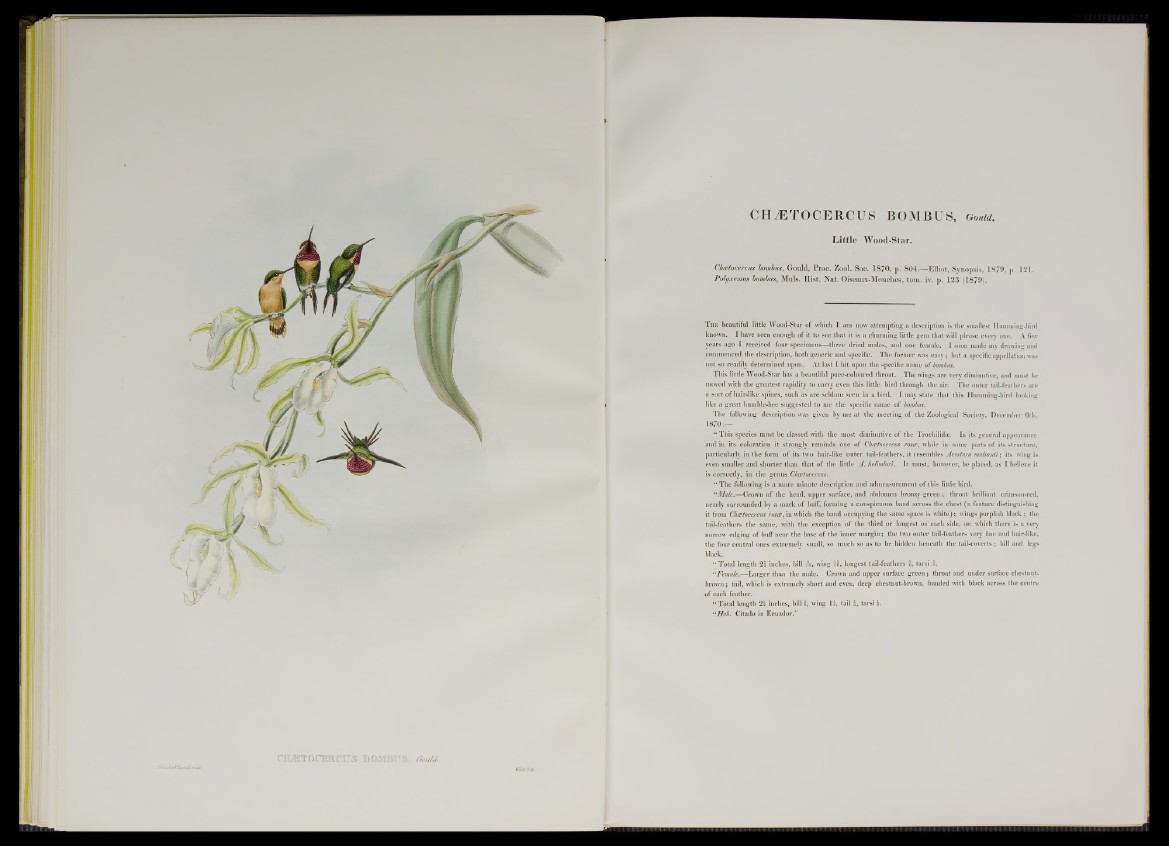
CBLETOCERCUS BOM Gould/.
CHÆTOCERCUS BOMBUS, m m
Little Wood-Star.
Choetocercus bombus, Gould, Proc. Zool. Soc. 1870, p. 804;— E lio t, Synopsis, 1879, p. 121.
Polyxemus bombus, Muls. Ilis t. N a t. Oiseaux-Mouches, tom. iv. p. 12 3 (1879).
T he beautiful little Wood-Star o f which I am now attempting a description is the smallest Humming-bird
known. I have seen enough of it to see that it is a charming little gem that will please every one. A few
years ago I received four specimens—three dried males, and one female. I soon made my drawing and
commenced the description, both generic and specific. The former was easy; but a specific appellation was
not so readily determined upon. At last I hit upon the specific name of bombus.
This little Wood-Star has a beautiful puce-coloured throat. The wings are very diminutive, and must be
moved with the greatest rapidity to carry even this little bird through the air. The outer tail-feathers are
a sort o f hair-like spines, such as are seldom seen in a bird. I may state that this Humming-bird looking
like a great humble-bee suggested to me the specific name of bombus.
The following description was given by me at the meeting of the Zoological Society, December 6th,
1870:—
“ This species must be classed with the most diminutive of the Trochilidas. In its general appearance
and in its coloration it strongly reminds one of Cheetocercus rosce, while in some parts of its structure,
particularly in the form o f its two hair-like outer tail-feathers, it resembles Acestura mulsanti; its wing is
even smaller and shorter than that of the little A. heliodori. It must, however, be placed, as I believe it
is correctly, in the genus Cheetocercus.
“ The following is a more minute description and admeasurement of this little bird.
“Male.—Crown o f the head, upper surface, and abdomen bronzy green ; throat brilliant crimson-red,
nearly surrounded by a mark of buff, forming a conspicuous band across the chest (a feature distinguishing
it from Cheetocercus rosce, in which the band occupying the same space is white); wings purplish black ; the
tail-feathers the same, with the exception of the third or longest on each side, on which there is a very
narrow edging of buff near the base of the inner margin; the two outer tail-feathers very fine and hair-like,
the four central ones extremely small, so much so as to be hidden beneath the tail-coverts ; bill and legs
black.
“ Total length 2i inches, bill A , wing I f, longest tail-feathers I, tarsi £.
“Female.—Larger than the male. Crown and upper surface green; throat and under surface chestnut-
brown ; tail, which is extremely short and even, deep chestnut-brown, banded with black across the centre
of each feather.
“ Total length 2i inches, bill I, wing l i , tail i , tarsi i.
“Hab. Citado in Ecuador.”